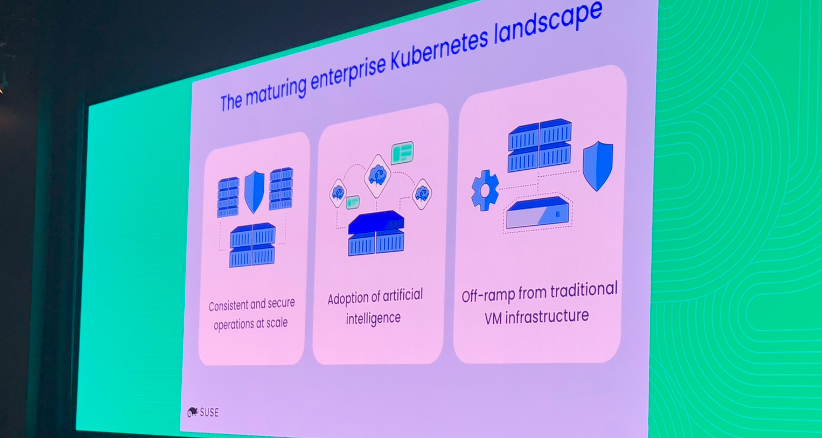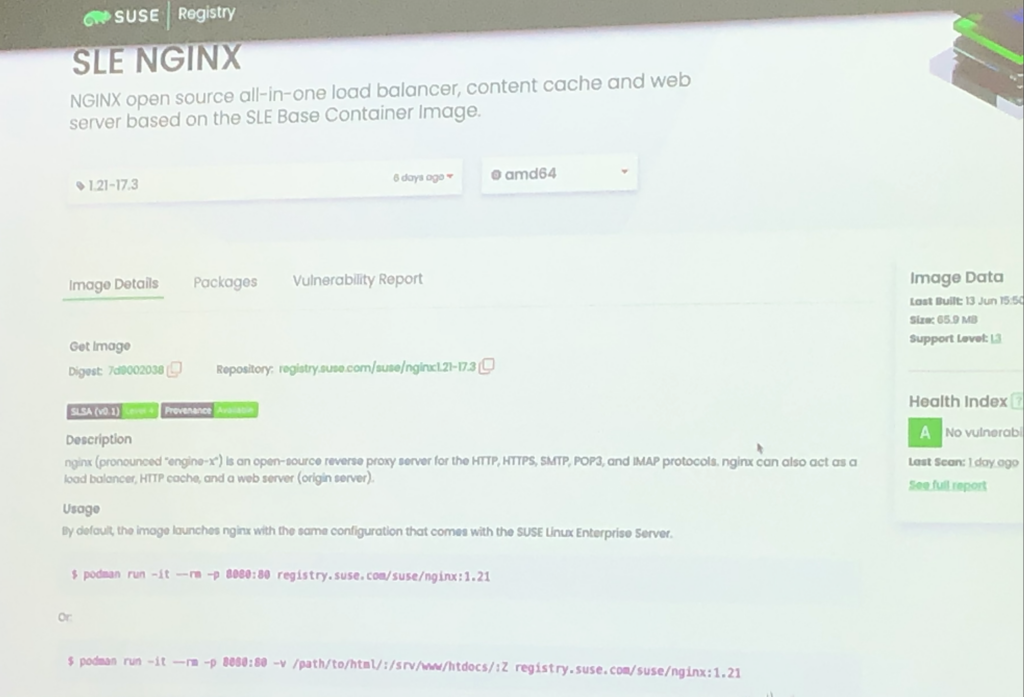As part of the SUSE partner program, we were warmly invited to attend the SUSECON 24 in Berlin with my colleague Jean-Philippe Clapot. A two and half days event where we joined the SUSE family to learn more about their strategy and vision. “SUSE Make Choice Happens” with their Open Source Solutions extended with the PRIME support and advance offering. This conference in Berlin was clearly the place to hear about the latest announcements, directly from SUSE. The round table featured discussions on trendy topics such as SUSE’s “partner first” strategy, Linux, the Cloud Native, the Edge and the Generative AI.


I would like to thank Nico Lamberti in particular for the great collaboration we’ve had over the last few months. With his help, we have succeeded in strengthening synergies between SUSE and dbi services in terms of technical know-how and sponsorship. The success of our Rancher & NeuVector technical webinar and community events hosted by dbi and powered by Sequotech, such as the Data Community Conference perfectly illustrate our partnership with SUSE. That’s just a few examples, there’s many more joint events to come …

For my first participation at SUSECON, the objective was not only to participate in the technical sessions, follow the keynotes for new announcements or visit the technology presentation booths to discover SUSE products and sponsor demonstrations…. but also to reinforce our partnership, meet new people and freely share ideas on Linux, Cloud Native, Edge and AI.
Through this blog post, I’ll try to summarize what I discovered and what I learned!
I hope you’ll enjoy reading it.
The keynotes announcements.
The recent acquisition of StackState by SUSE was presented to the audience, who applauded warmly the arrival of this Ultimate Cloud Native offering in SUSE portfolio. StackState provides end-to-end observability capabilities, impressively expanding the SUSE Ecosystem. The key consideration around StackState is that it stretches out observability to include database, endpoints, message queues, and more – not just the Kubernetes setup.
From the Linux distributions, to managing and handling container workloads with Rancher, to Zero-trust security tools adding attack detection and protection with NeuVector, to Harvester that handles VM workloads along with containers, StackState covers it all ! Its observability capabilities are purely impressive.
This StackState platform will most probably be integrated into Rancher Prime at first, and we truly hope that it will also be available as an Open Source solution later on.
Liberty Linux and SUSE AI were also presented during the Keynotes.
SUSE provides a complete ecosystem for running VM and containers workload in the Cloud or On-Prem as Open Source with the possibility to get extended support and capability through the PRIME offering !
The Keynote was focusing on the following 4 main axes:
- Linux
- Cloud Native
- Edge
- AI








During the last day of the keynote, we got an overview of the latest innovations on SUSE Linux : a new Linux kernel is being introduced.
Additionally, SUSE will extend its Linux support, thus becoming the vendor to propose the longest support period in the industry.
Harvester was also in front of the announcement : It does not intent to become a replacement of VMWare but an alternative for those who already did the choice to modernise their Platform, bridging Virtualisation and Cloud Native (Running VM along with containers workload is where Harvester is coming into the picture).
Few figures have been presented to us, SUSE ecosystem is impressive and it will continue to grow :
- SUSE’s 30 years of Open-Source Solution counts more than 50’000 active Rancher users
- more than 10 millions downloads of K3s monthly,
- 68% of Harvester YoY growth and download growth
- more than 125’000 Longhorn managed nodes
Latest updates and information about the Kubernetes Landscape and Rancher Prime 3.1 update :







Summary of the most interesting technical sessions I followed
The DEMOPALOOZA.
During the last session we followed before leaving, we could participate into a fun presentation on SUMA, Rancher, AI, Harvester, etc
It was presented in a playful way, with role play simulating crash and restoration of linux state, presenting capabilities of the SUSE AI solution and so on.
Really interesting way to conclude the SUSECON with a touch of humor.

Multi-tier management and observability of Edge clusters with Rancher

Edge clusters
During this session, the edge computing was explained and shoewed that the next challenge will be to manage very large scale infrastructures and observe more and more clusters, not only hundreds but it will soon become tenth of thousands of clusters.
The limits are pushed beyond what a single Rancher manager can currently handle. High quality and user experience must be kept in mind for maintaining clusters at large scale, focused on observability. For that purpose, Hub Rancher Cluster is a new feature that will allow to manage a set of spoke clusters where multiple downstream clusters will be attached. The Hub Rancher will receive aggregated information from each Spoke’s Downstream clusters and Grafana dashboard will allow to display overall information about the health of downstream clusters. A “drill down” capability is implemented to have a detailed overview of the whole edge platform of a company. Grafana Mimir is used to store all this data and present them in a consolidated dashboard view.
This feature is not yet available. It should be rolled out soon!




Cloud-Native Software Virtual Machines

I really liked this session as it was about Software Virtual Machine such as the JVM, the eBPF program and WebAssembly. The speaker explained what’s really behind this concept, its origins, and describing eBPF, WebAssembly and Edge applications at a high level. This really shows the evolution of the Software Virtual Machine since the beginning till today, showing that eBPF and WebAssembly will be the perfect match.





Deep Dive into the SUSE Customer Centre, RMT and SUSE Registry
The last technical session I followed was about the value of subscribing to SUSE, the key take aways were the following:
- Trusted open-source supply chain
- Linux, infrastructure and container management
- Maintenance and security updates
- Documentation & knowledge base
- Technical support
The trusted official SUSE container image provides several benefits:
- Easy discovery
- Rich information
- Vulnerability reports
- Image documentation
- Search and filtering
- Access exclusive subscriber-only content
A self-hosted, supported container image and OCI artifact repository can also be deployed On-Prem without external access requirements when pulling image from a Kubernetes cluster.
The benefits of this private registry are:
- Designed to work with the entire SUSE portfolio
- Host official SUSE images and helm charts, as well as your own
- Role-based access control
- Vulnerability scans

Thanks to the organiser of the event as well as the SUSE employees. I had the chance to discuss with some of them outside, during the party or when taking break between the sessions !
![Thumbnail [60x60]](https://www.dbi-services.com/blog/wp-content/uploads/2022/08/ABE_web-min-scaled.jpg)
![Thumbnail [90x90]](https://www.dbi-services.com/blog/wp-content/uploads/2025/05/martin_bracher_2048x1536.jpg)
![Thumbnail [90x90]](https://www.dbi-services.com/blog/wp-content/uploads/2024/03/AHI_web.jpg)
![Thumbnail [90x90]](https://www.dbi-services.com/blog/wp-content/uploads/2022/08/HER_web-min-scaled.jpg)